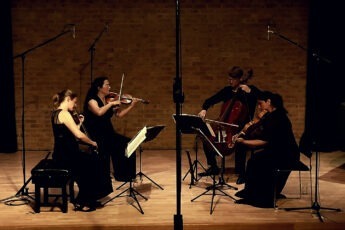This piece is a re-setting of a 1965 poem—or ‘milonga’—by Jorge Luis Borges. Milonga is a Habanera-cum-polka dance form and musical genre, which originated in Buenos Aires in the late nineteenth century—a predecessor to the modern tango with rustic and often provocative or political themes. Borges’ poem was originally set to music as one of four ‘Canciones Porteñas’ in 1968 (Fig. 2.1) by composer and fellow Argentine, Astor Piazzolla. I decided to set the first two stanzas, inspired by the recorded performance of Edmundo Rivero and the Nuevo Tangoi quintet. While the third stanza (which is recited) and the fourth stanza (which returns to song in a concluding verse on the magnanimity and symbolic nature of this masculine character) are clearly important to the shape of the original poem, I felt that the narratively open-ended and enigmatic pause at the end of the second stanza is where I wanted my piece to end, for obvious dramatic reasons. This also has something to do with the subversiveness of translation and concepts of intercultural exchange more generally.
Despite this narratively more ambiguous ending, I present the text in its original Spanish form relatively clearly and precisely—in many ways faithful to the spirit of the poem to this point. The musical language is not recognisably Argentinian to match aspects of Piazzolla’s style but does reference various tango-like harmonic and rhythmic features (albeit irreverently). The text retains a proud and jocular air, resembling the character of the milonga form and the character of Jacinto himself in Borges’ poem. The text, while somewhat fragmented in its delivery, has not been adapted or reordered in any way; on the surface, it retains its meaning. However, an underlying anxiety is expressed through the way the ensemble members must ‘speak up’ and share in the process of translating the Spanish text into English. I see this collaborative effort as imbuing the textual communicativity of the piece with a transcultural tension to match the way the music mirrors, distorts and reinvents tango-like forms. They must express themselves but also speak as one voice. This is a political act that encourages performers to reassess their performative function and explore their body-voice relationship and physical presence through a referenced textual and musical style that also expresses a body-voice relationship and a heightened physicality. The way the broken lines of translation move between different voices represents an atomisation of meaning and the tension between dramatic and postdramatic styles.
This translational tension, created through the musical and textual dialogue, verges on the absurd. The instrumentalists (in this instance, CHROMA Ensemble) are asked to be voice actors. The soloist (baritone Filippo Turkheimer)—singing lyrical, poetic lines—is always undermined by their short, interlocutory performances. The blunt translation chosen for the ensemble to speak (see overleaf) doesn’t transmit the same poetry and signs of Borges—its directness is paradoxical, for it gives a literal conversion into English without expressing the cultural nuance much at all. Musically, exact repeated chords dramatically oppose the speech-based dialectical drama taking place around it, as does the music’s reliance on quarter tones, which function both as passing tones (metaphorically semantic suturing devices) and pitches derived from the harmonic series (usually on a C fundamental, metaphorically acting in opposition to Piazzolla’s key of B minor). All of these creative choices lead to music that should perhaps oppose the speech elements of the piece, but strangely they seem to support the metanarrative, revealing something about the search for meaning in languages (abstract versus concrete) and the nature of culture as both ephemeral and untranslatable.



